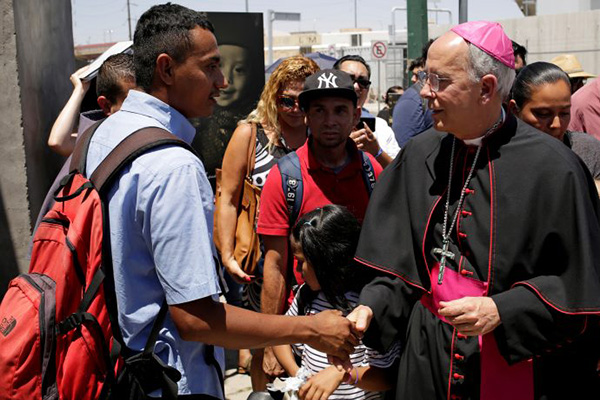
By Christopher White, The Tablet’s National Correspondent
NEW YORK — While immigration remains a political flashpoint in the United States, Catholic Church leaders continue their efforts to stand with migrants in the face of opposition and will once more come together on both sides of the border with a Mass this weekend.
On Saturday, Bishop Mark Seitz of El Paso will celebrate the Mass, along with Bishop Peter Baldacchino of New Mexico and Bishop Guadalupe Torres of Ciudad Juárez, in Mexico.
The Mass on the border is the latest of high-profile public events meant to spotlight the plight of migrants at the southern border, where earlier this year Seitz personally accompanied asylum seekers from Mexico to the U.S. after they had previously been denied entry.
In a statement ahead of the event, the Diocese of El Paso said the Mass is meant to highlight the unity of Catholics on both sides of the border.
“In this time of high polarization around the immigration debate, discrimination, militarization of the border, and a wide spread spirit of exclusion in our nation, the Border Mass continues to remind us that we are called to live in communion,” the statement read. “There is no ‘us and them,’ but one family of God.”
“With so many challenges and with thousands of our brothers and sisters suffering the consequences of racist attacks and of our broken immigration system, it is fundamental that our Church at the border continues to speak up on behalf of our migrant and refugee brothers and sisters with the prophetic voice of the Gospel,” the statement continued.
Last month, the dioceses came together for Latinx Catholic Leadership Coalition, a teach-in event co-sponsored with the Hope Border Institute in response to “inhumane treatment of migrants and refugees at the border” and the August El Paso shooting where a gunman specifically targeted Latinos. That event included a walk across the Laredo International Bridge to visit asylum seekers in Mexico.
In a landmark pastoral letter on racism released at the conclusion of last month’s teach-in, Seitz, who has become one of the U.S. Church hierarchy’s most vocal defenders of immigrants, lamented the “xenophobia ravaging the United States” and described President Donald Trump’s border wall as a “monument to hate.”
The document was the first of its kind by a church official, addressing racism from the perspective of the border and calling for an end of further deportations until the nation overhauls its immigration policies with pointed words for government officials.
This year’s joint border Mass marks the twenty-second annual gathering, which dates back to 1998. For nearly two decades, the Mass was held at the U.S.-Mexico border fence in Anapra. In 2016, it was moved to the Rio Grande canal near the Santa Fe Bridge.
“The Mass signifies our unity in diversity, our communion and mutual support, our ongoing encounter and accompaniment, as we seek to respond to our refugee and migrant brothers and sisters at our door,” said a diocesan statement.
“Borders, in the spirit of the Eucharist, exist not to separate and divide, but to identify and complement one another,” the statement continued. “Borders are where we encounter each other and create thriving communities in unity and diversity. Borders are places where we share each other’s journey.”
